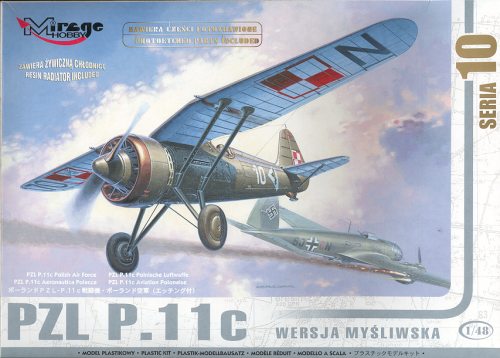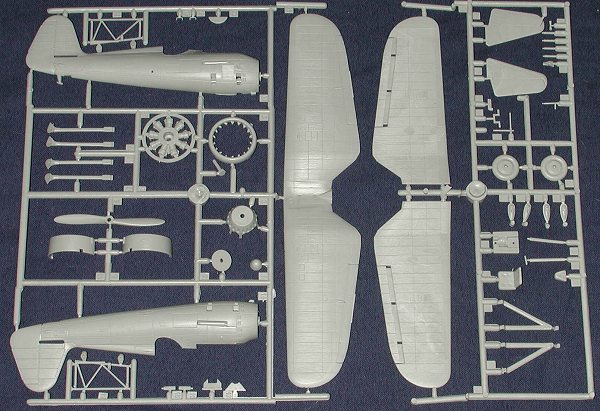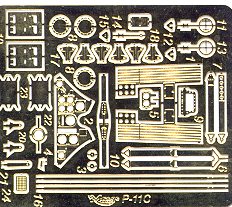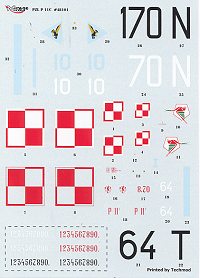
|
KIT: |
Mirage 1/48 PZL P.11c |
|
KIT # |
48101 |
|
PRICE: |
$22.98 ($19.96 from Squadron) |
|
DECALS: |
Two aircraft |
|
REVIEWER: |
|
|
NOTES: |
Multi-media kit with etched brass and resin |

|
HISTORY |
The PZL P.11 was one of the line of fighters designed by Zygmunt Pulawski, which, in the early thirties, for a short time brought Poland to the forefront of fighter development. The basic concept of the line, which was first realized in 1929 in the PZL P.1 prototype, was that of an aerodynamically clean high-wing monoplane of all-metal construction. The characteristic bent "gull-like" shape of the wings was adopted to reduce drag by eliminating the need for any supporting structure between the center section and the fuselage and, coupled with an in-line "Vee" engine, provided excellent all-around visibility.
In 1929 it was decided that only air-cooled radial engines would be produced in Poland, and this necessitated changes to the design. As Bristol Jupiter engine had been selected for license production in the Polish Skoda works, two new variants of the plane were prepared - PZL P.6 with Jupiter VIFH engine, and PZL P.7 with the low-altitude Jupiter VIF engine variant. Both of these featured new, semi-monocoque fuselage.
The PZL P.11c was designed in an attempt to improve visibility from the cockpit, which was achieved by lowering the engine installation and moving the pilot's seat upwards and back. The fuselage and tail were redesigned, and the provision was made for installing additional two machine guns in the wings (the PZL P.11a had two Vickers F 7.9mm machine guns in the fuselage). 175 airplanes were ordered, and delivered to the Lotnictwo Wojskowe from 1934 to 1936 in two series, fitted with Polish license-built Bristol Mercury VS2 and VIS2 engines. The P.11c prototype was later fitted with Gnome-Rhone engine, and delivered to Romania, which acquired a license and built 70 of these aircraft, designated PZL P.11f, during 1936-38 in the IAR factory at Brasov.
In 1939, when Nazi Germany invaded Poland, the PZL P.11 was outclassed in terms of performance by both Messerschmitt Bf 109 and Bf 110 fighters. It also had absolutely inadequate firepower, 70% of the aircraft being equipped only with two 7.9 mm machine guns (and pilots often preferred these over the four-machine gun version, saying that additional weight affected the plane's performance - especially the climb rate!) It was, however, very maneuverable and sturdy airplane, and its short take-off facilitated operations from improvised airfields. A unique feature was its jettisonable fuel tank. However, it had no armor protection for the pilot. Throughout the September campaign P.11s operated in very difficult conditions, with no repair facilities and inadequate spare parts supplies (and all of them were 3 to 5 years old!). Despite of all these adversities, P.11 pilots claimed almost 120 confirmed kills, including 10 Bf 109s and 13 Bf 110s. Only 26 P.11 fighters were destroyed in combat by German fighters which, in view of German numerical and technical advantage is quite a low number.
Thanks to the Polish Aviation History site www.s-studio.net/polavhist/index.html for the above description.
|
THE KIT |

I must honestly tell you that I was pretty excited about this kit when I first heard it was being released. First because I've always liked this little fighter and second because it meant that I didn't have to suffer through the LTD version! I was quite impressed with the Mirage 1/400 U-boat I built some time back and so was looking forward to this being a nice kit. I'm not disappointed at all. Yes, it is still a bit of a short run kit. You do have to make some smaller bits and do some refinement work on parts prior to assembly, but it is to be expected.
This kit has excellent detailing, especially on the corrugated wing. One very nice touch is that the edges of the control surfaces have been molded with a bit of a gap, just like on the real plane. This is the first time I've seen this on a kit and I applaud Mirage for doing so. In terms of the usual things I look for, there are some sink marks on the thicker parts, such as the ends of the wing struts and on a few spots on the fuselage. They appear to be easy to fill. The mold seams are a bit large on some parts and the mating surfaces will need to be properly sanded down to get rid of some very minor irregularities. Again, normal for a short run kit.
 The cockpit is very complete with
framework, seat, stick, rudder pedals and the like. Howe much one will be able
to see through the small opening is conjectural, but at least the builder will
know it is there! In addition to a plethora of small plastic bits, the kit comes
with a very shiny and a bit thicker than normal etched fret. This includes a
number of reinforcement pieces as well as the instrument panel, seat
belts, control surface hinges and other small, fiddly bits. A single resin piece
is provided for the side radiator and it needs to have about half of its
thickness removed before it can be used.
The cockpit is very complete with
framework, seat, stick, rudder pedals and the like. Howe much one will be able
to see through the small opening is conjectural, but at least the builder will
know it is there! In addition to a plethora of small plastic bits, the kit comes
with a very shiny and a bit thicker than normal etched fret. This includes a
number of reinforcement pieces as well as the instrument panel, seat
belts, control surface hinges and other small, fiddly bits. A single resin piece
is provided for the side radiator and it needs to have about half of its
thickness removed before it can be used.
Instructions are quite good and leave no doubt as to what goes where and how it should look when finished. Color information is given in generic terms and Humbrol colors. The instructions are on one side of a large sheet with decal and paint information on the other. It is obvious from reading the instructions that this same sheet is used for all three boxings of the P.11c.
On the other side is the camo and decals information. There is a brief historical section, including the relevance of each of the three decal options given for this plane. All are painted in dark green over light blue. Aircraft 64 was flown by the top scoring Polish pilot of the 1939 campaign with 4 personal and 1 shared victory. #10 was second in this listing with 4 personal victories. This aircraft is shown in two markings. One is with white underwing numbers and the other is when the numbers were changed to black in the summer of 1939. The side number is given as light blue or white as the actual color cannot be ascertained. The decals themselves are printed by Techmod and so you know that the quality is good.
|
CONCLUSIONS |
Many have been awaiting this kit and I'm sure it will end up being a great seller. I've already started on this one and so far have not had any real problems with it. Because of the etched metal bits I'd suggest having a few short run kits under your belt before trying this one.
You can find this kit and many others at

If you would like your product reviewed fairly and quickly by a site that has well over 175,000 visitors a month, please contact me or see other details in the Note to Contributors.